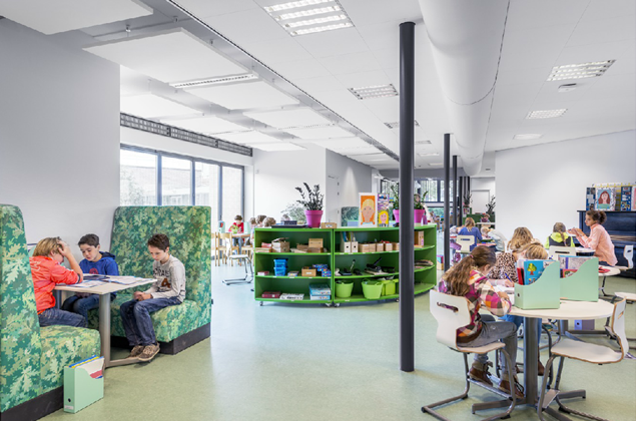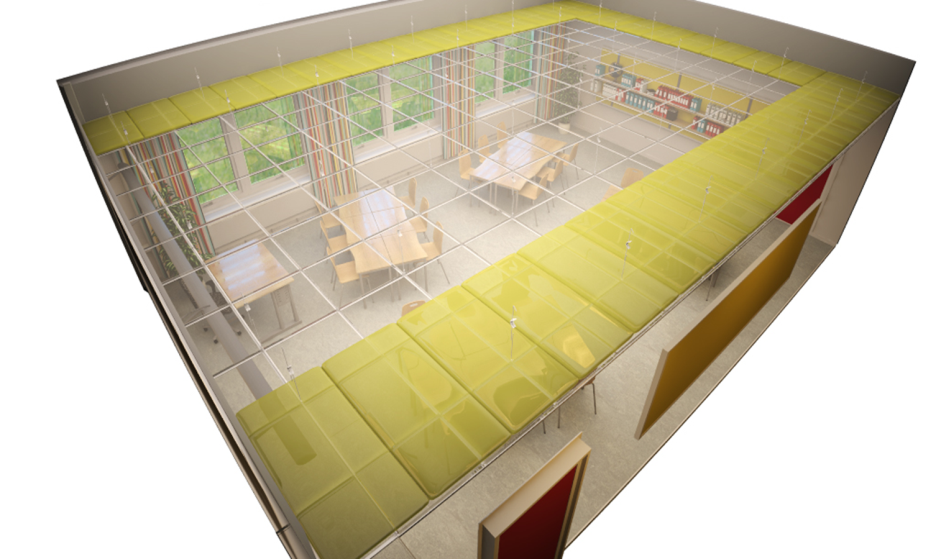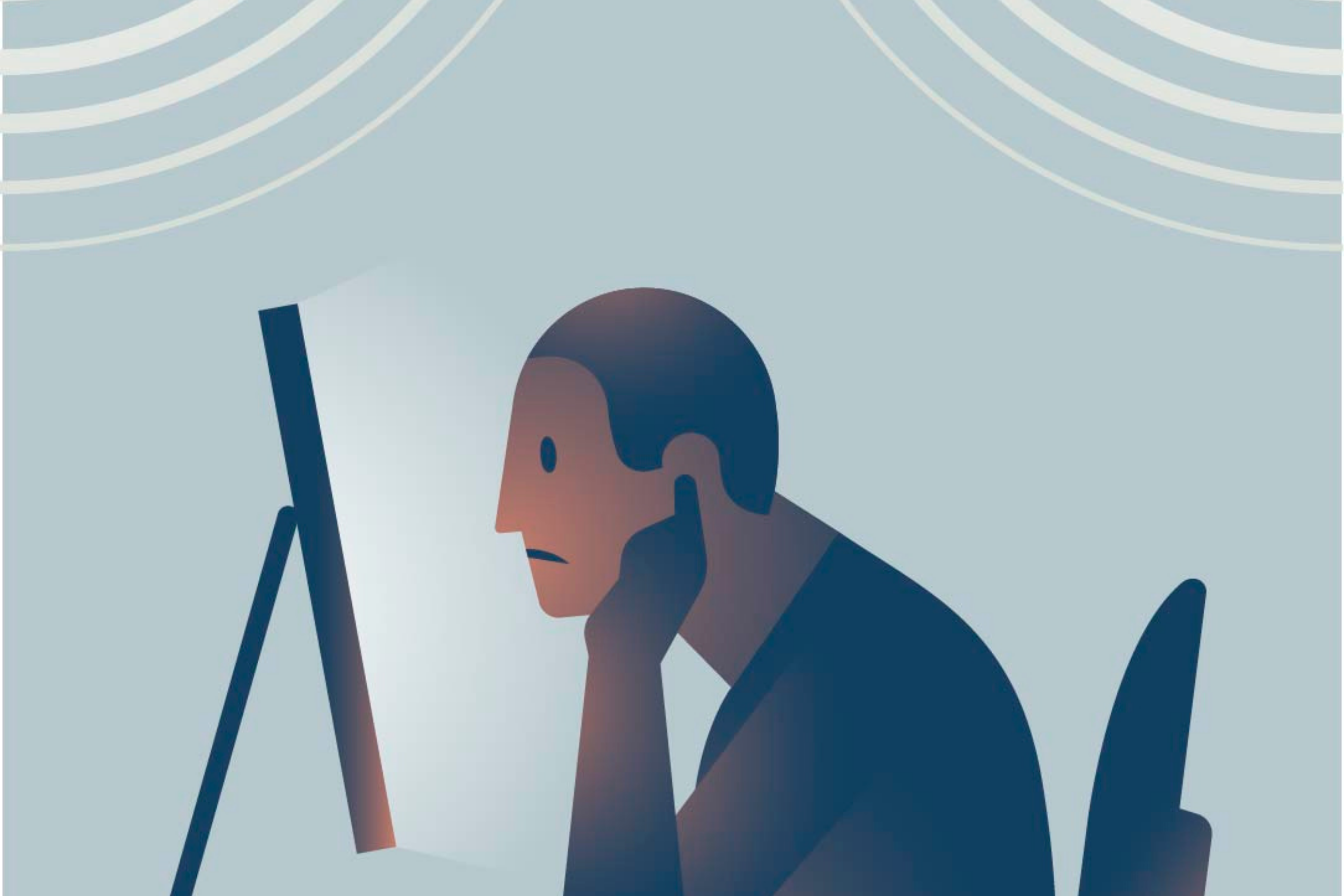
A vibrant soundscape in any educational context, be it within a preschool, school or university, usually means a healthy learning environment. Students engaging with their education actively often generate more sound as they enthusiastically critique, consider and explore their learning materials and communicate with their teachers and peers. To counteract this, acousticians have striven for decades to reduce noise levels in classrooms. But could the answer be to strategically add more noise into the mix?
One of the major challenges for acoustic design of educational soundscapes is to create an environment in which auditory disturbances do not actually disturb anybody. Where constructive sound does not become invasive for others. Where the built environment actually contributes to the process of listening, communicating and concentrating. Among other things, this means enhancing the clarity and intelligibility of speech as well as placing limits on overall indoor sound levels and sound propagation.
Traditionally, this has been done in two ways. The first is going out of fashion, namely the rigorous inhibition of noisy activities through behavioral control (let’s call this the “children should be seen and not heard” approach). Unfortunately, this approach does not prepare children for the real world, in which they will be expected to interact with each other and engage actively with their own learning process in order to obtain the 21st century skills they will need to thrive.
 The second approach is a rather more sensible and sustainable solution to the problem of noise. Namely, the physical manipulation of materials used in the building process. Changing sound-reflective surfaces such as ceilings and walls to sound-absorptive materials are an ideal solution for this, capturing and neutralizing the reflected sounds which form an echoic din if left unchecked.
The second approach is a rather more sensible and sustainable solution to the problem of noise. Namely, the physical manipulation of materials used in the building process. Changing sound-reflective surfaces such as ceilings and walls to sound-absorptive materials are an ideal solution for this, capturing and neutralizing the reflected sounds which form an echoic din if left unchecked.
However, a third voice has emerged. This voice claims that the solution could be to introduce competing sounds – of a very specific nature and quality – into the environment. Noises that are capable of masking the maskers. They argue that, properly applied, piping noise into spaces where sound has traditionally been problematic, such as open-plan offices and schools, could actually help us to positively shape the sound environment in those spaces in various ways.
What is sound masking?
Sound masking is when noise-producing speakers are strategically placed in the indoor environment with the sole purpose of drowning out irrelevant sounds. Companies that produce sound masking solutions such as Cambridge Sound claim that “ambient background sound” is an effective tool for reducing noise distractions, increasing acoustic comfort and protecting the privacy of what is being said. In schools particularly, it claims to increase student engagement and reduce stress. However, although sound masking has been used since the 1990s, currently there is no consensus on whether adding more sound into the mix is the solution to the problem of too much sound.
But what are the potential strengths and weaknesses of such an approach, based on what we know about the auditory system and how the brain processes sounds?
Is all noise equally noisy?
Our hearing system and brain respond to different types of noise in distinct ways. For example, having a ventilation system in earshot affects how one hears speech differently from having someone speaking on their mobile phone nearby. Interestingly, this is true even if the two signals are constructed in the laboratory to have almost the same characteristics.
hearing system and brain respond to different types of noise in distinct ways. For example, having a ventilation system in earshot affects how one hears speech differently from having someone speaking on their mobile phone nearby. Interestingly, this is true even if the two signals are constructed in the laboratory to have almost the same characteristics.
Studies have examined children’s ability to recognize words in the presence of different types of noise, including noises that are identical in all respects except that one sounds more like speech than the other. Findings have shown that speech-like noise tends to be more effective in masking relevant speech sounds than non-speech-like noises.
For example, MacCutcheon et al. [1] compared different types of noise maskers’ effect on children’s ability to detect target words. The masker types had nearly identical average spectral properties and differed only in how speech-like they sounded. The researchers found that a babble noise consisting of many voices was 3 dB more effective at masking words than white noise. This effect became even more pronounced when the speech-like noise had distinctly audible words; with a single talker as the noise masker, the speech could be 6 dB quieter than the white noise in order to have the same masking effect [2].
So, not all noises are created equal. White noise (a so-called “energetic masker”) acts simply by blocking the target sound’s energy from being registered in the cochlea. That is, at the most basic level of the auditory system. Meanwhile, speech-like noises (“informational maskers”) cause problems at the cognitive level, as the speech information interferes with attention, memory and language processing in the brain [3].
Taking this essential difference between noise types into account, it could be reasonable to consider whether noise that is not speech-like could be a useful candidate for drowning out competing noises such as the voices of loud colleagues in the office or children in the classroom.
However, there is more to the story.
Both types of maskers are equally stress-inducing. In a recent study comparing the stress caused by informational and energetic maskers with silence, Radun et al. [4] found no significant difference between the two masking conditions. Both noises produced the same stress responses in listeners, and were perceived to be significantly more stressful than silence. And since stress also interferes with cognitive function, it could be that this cancels out some of the cognitive benefits of replacing an informational masker (eg. people talking) in the environment with an energetic one (eg. sound masking noise).
Adopting a strategy of covering up the noise rather than reducing it, for example with sound-absorption, forgets another essential factor: noise is extremely annoying! In fact, studies comparing subjective ratings of annoyance with different types of noise have found them to be equally annoying, be they speech or non-speech in nature [5]. And of course, annoyance doesn’t exactly improve cognitive performance either.
In conclusion: what should we prioritize when designing the acoustic environment?
Due to a lack of scientific evidence, it’s not possible to conclusively say whether sound masking is the answer to classroom noise. Although, it represents an intriguing possibility, especially in contexts in which privacy is important or where excessive irrelevant speech and other noises are unavoidable. However, it would not make sense to use sound masking when attempts have not been made to reduce the build-up and spread of noise in the classroom first.
The illustration below considers the sequence of priorities when designing a classroom soundscape, which is helpful in considering sound masking’s place of importance.
The sequence of priorities is clear: everything that can be done to make the physical environment as conducive to learning as possible before introducing additional sounds into the environment. Otherwise, we are only dealing with the symptom and not the root cause. Anything else would be covering up poor acoustics with an auditory Band-Aid.
As such, we conclude that sound masking could be a useful final step, once the scientific basis for its use has been properly established in the limited number of educational contexts in which it is likely to be useful.
Author: Douglas MacCutcheon
Douglas is Ecophon’s Global Concept Developer for Educational Environments. He has a doctorate in psychoacoustic research, focused on how noise affects learners’ understanding and processing of speech in the classroom. When he isn’t campaigning for better classroom acoustics, you can find him engaged in the quietest of all sports: sailing.
Sources
[1] MacCutcheon, D., Pausch, F., Fels, J., & Ljung, R. (2018). The effect of language, spatial factors, masker type and memory span on speech‐in‐noise thresholds in sequential bilingual children. Scandinavian journal of psychology, 59(6), 567-577.
[2] MacCutcheon, D., Pausch, F., Füllgrabe, C., Eccles, R., Van der Linde, J., Panebianco, C., … & Ljung, R. (2019). The contribution of individual differences in memory span and language ability to spatial release from masking in young children. Journal of Speech, Language, and Hearing Research, 62(10), 3741-3751.
[3] Brungart, D. S. (2001). Informational and energetic masking effects in the perception of two simultaneous talkers. The Journal
of the Acoustical Society of America, 109(3), 1101–1109.
[4] Radun, J., Maula, H., Rajala, V., Scheinin, M., & Hongisto, V. (2021). Speech is special: The stress effects of speech, noise, and silence during tasks requiring concentration. Indoor air, 31(1), 264-274.
[5] Brocolini, L., Parizet, E., & Chevret, P. (2016). Effect of masking noise on cognitive performance and annoyance in open plan offices. Applied Acoustics, 114, 44-55.


